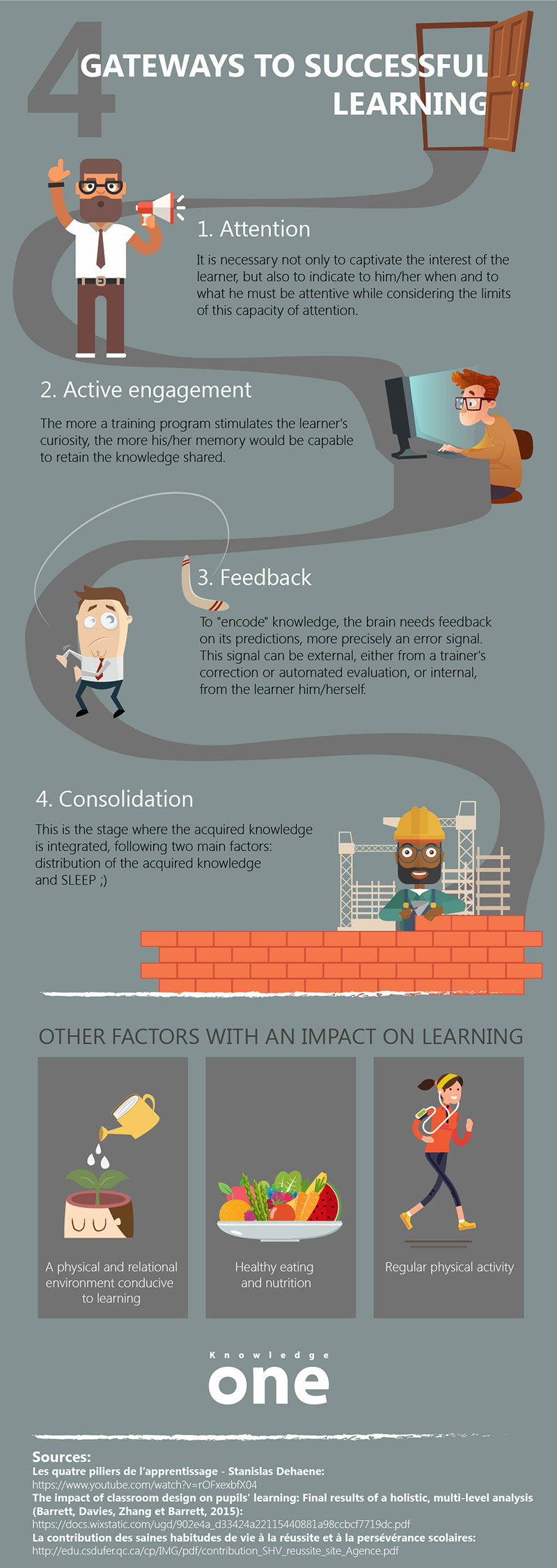While there are several valid teaching methods, the latest discoveries in neuroscience have identified four factors necessary for successful learning. Compatible with the freedom and experimentation that remain important in pedagogy, these guiding factors can be integrated into various learning approaches.

-
Attention
It is the gateway to all learning process and a decisive factor in its success. To open it, it is necessary not only to captivate the interest of the learner but also to indicate to him/her when and to what he must be attentive while considering the limits of this capacity of attention.
Keep in mind that the idea of “multitasking” is actually a myth. The brain is designed to prioritize information and focus on performing one task at a time, by inhibiting unwanted distractions and behaviors, and by automating the second largest request. To send to it a second task is therefore counterproductive. However, as good news, attention is an ability that we can work on!
-
Active engagement
The more a training program stimulates the learner’s curiosity, the more his/her memory will be capable of retaining the knowledge shared. Using “riddles” or questions related to the knowledge a learner should possess is an appropriate avenue to increase this active engagement. Thinking, seeking to understand and making predictions also contribute to better retention of knowledge.
When seeking engagement, the degree of difficulty is an important factor: it must not be too easy or too difficult, but still, involve a certain challenge, i.e., a degree of difficulty sufficient for the learner to shows more attention or engage in an additional cognitive effort.
To this set of conditions favoring active engagement, let us add the test, this exercise that allows the learner to identify what he does/does not yet know. The winning formula alternates between studying and testing, more specifically: 4 learning sessions preceding a test.
-
Feedback
The saying that one learns from one’s mistakes is not a myth! It is the right to err that is here in focus. Because, although necessary, active engagement is not enough. To “encode” knowledge, the brain needs feedback on its predictions, more precisely an error signal. This signal can be external, either from a trainer’s correction or from automated evaluation, or internal, from the learner him/herself. In the latter case, the learner discovers that there is a gap between his/her prediction and his/her observation. To trigger the learning, it is necessary that this signal of error causes in the learner a feeling of surprise.
Another important point: the corrections must not be similar to sanctions. Even if the negative feedback – which is to say that a person has made a mistake – is effective when applied to adult learners, they must feel that they are corrected with kindness; otherwise, stress and helplessness could thwart their learning.
-
Consolidation
This is the stage where the knowledge acquired is integrated. A bit like the memory of a computer, the conscious and explicit treatment of a learning process takes up space in the brain. To optimize this treatment, knowledge must be received in reasonable doses, over several relatively short periods. In order to do a thorough treatment, the brain must free up space by automating the previous learning process. For example: before processing an equation, he must automate the formula.
The other essential condition for the consolidation of knowledge is … SLEEP! Indeed, it is during sleep that the hippocampus, this key structure of memory, is the most active. Although its role remains partly to be clarified, we know that it replays the day’s information to transfer them to the cortex where they are stored in the long term. It is believed that the hippocampus could determine what information is to be consolidated. Thus, if the future belongs to those who get up early, they must not have gone to bed too late!
Extra, essential factors
Let’s not forget that other factors have been identified as having a significant impact on learning, including a physical and relational environment conducive to learning, as well as healthy eating and nutrition, and regular physical activity.






